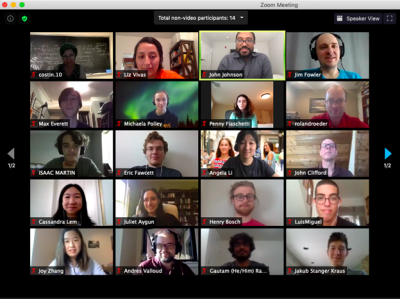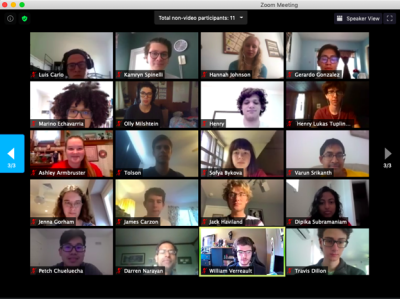By Liz Vivas and Jim Fowler

The Young Mathematicians Conference (YMC) held at Ohio State has become one of the premier ways to showcase undergraduate research. It has been held at Ohio State since 2003, and it emphasizes the dissemination of undergraduate research activity in mathematics. A previous newsletter article reviews more information and history of the YMC.
Because of the danger of the pandemic, YMC 2020 had to be reprogrammed to be held online. Making matters more complicated, much of the research showcased at the YMC is the result of undergraduate participation in “research experiences for undergraduates” (REUs), which are generally in-person, residential opportunities. With the pandemic, many of the REUs were either canceled or moved online, with all the challenges of moving deep, collaborative research into geographically distributed, online experience.
Despite these challenges, Ohio State was committed to running YMC 2020, and the result was a successful online conference. The conference was held Aug. 14-16, and although there were significant challenges faced by many REU programs, there was nevertheless considerable interest in the YMC. Through a competitive process involving a jury of abstract evaluators, we accepted 72 abstracts for either individual or team presentations.
Online math talks involve special challenges, and we expected that not every undergraduate presenter would want to give a “live” Zoom talk. Students were provided with a choice for a live talk or a pre-recorded talk; in both cases, these talks were 20 minutes long. The live talks were presented in three parallel Zoom rooms, designed so that similar topics would be discussed in each room. This encouraged the presenters to engage with each other. The pre-recorded talks were made available on MediaSite, which Ohio State uses to stream video content, with links from Slack. In the end, these pre-recorded talks were more like a mixture of a poster session and a presentation, since interested viewers could engage with the video and then leave questions in the Slack for the presenter. Student reactions to this format were positive. Ohio State undergraduate Angela Li said the “YMC was a really eye-opening and fun experience, and it made me feel more welcome in the math community.”
In addition to Slack, YMC 2020 also involved breakout rooms in Zoom to facilitate discussion around graduate school opportunities. An in-person conference would have provided plenty of opportunity for informal discussion and serendipitous conversation. YMC 2020 could have had more such opportunities, but the Slack and breakout rooms provided a partial substitute.

Normally the YMC has three plenary sessions where distinguished mathematicians make their research broadly accessible. In the online format, the YMC ran two such sessions. The first was a plenary talk, “Extremal Geometric and Topological Combinatorics,” by Ohio State’s own Professor Matt Kahle, which featured some beautiful slides. The second talk was “The 3 Gaps Theorem, the Boshernitzan-Dyson Theorem, Frequencies, and Applications” by IUPUI School of Science Associate Professor Roland Roeder, which also highlighted a collaboration between Roeder and undergraduate researchers. These talks benefited from being presented on Zoom, so the resulting videos made for compelling YouTube lectures, and the YMC YouTube channel provides an additional venue for outreach by the Department of Mathematics.
Every challenge presents an opportunity, and the difficulties of the pandemic provided a chance for Ohio State to learn how to run the YMC conference online. This knowledge has helped as other conferences organized by Ohio State faculty that have necessarily been moved online. Although some REUs may run in-person in Summer 2021, the expectation is that the pandemic will still prevent significant academic travel, so the present plan is to run YMC 2021 in an online format similar to YMC 2020. Preserving what was successful in YMC 2020 and revising what was less successful will make YMC 2021 be an even better experience.
